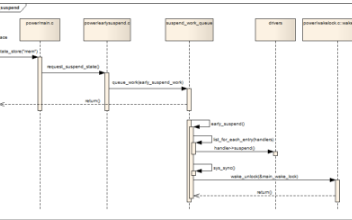DOWN操作:linux內核中,對信號量的DOWN操作有如下幾種:
void down(struct semaphore *sem); //不可中斷
int down_interruptible(struct semaphore *sem);//可中斷
int down_killable(struct semaphore *sem);//睡眠的進程可以因為受到致命信號而被喚醒,中斷獲取信號量的操作。
int down_trylock(struct semaphore *sem);//試圖獲取信號量,若無法獲得則直接返回1而不睡眠。返回0則 表示獲取到了信號量
int down_timeout(struct semaphore *sem,long jiffies);//表示睡眠時間是有限制的,如果在jiffies指明的時間到期時仍然無法獲得信號量,則將返回錯誤碼。
在以上四種函數中,驅動程序使用的最頻繁的就是down_interruptible函數,以下將對該函數進行分析。
down_interruptible函數的定義如下:
int down_interruptible(struct semaphore *sem)
{
unsigned long flags;
int result = 0;
spin_lock_irqsave(&sem->lock,flags);
if (likely(sem->count> 0))
sem->count--;
else
result =__down_interruptible(sem);
spin_unlock_irqrestore(&sem->lock,flags);
return result;
}
函數分析:函數首先通過spin_lock_irqsave的調用來保證對sem->count操作的原子性。如果count>0,表示當前進程可以獲得信號量,將count的值減1然后退出。如果count不大于0,表明當前進程無法獲取信號量,則調用__down_interruptible,后者會繼續調用__down_common。
__down_common 函數定義如下:
static inline int __sched __down_common(struct semaphore *sem, longstate,
longtimeout)
{
struct task_struct *task= current;
struct semaphore_waiterwaiter;
list_add_tail(&waiter.list,&sem->wait_list);
waiter.task = task;
waiter.up = 0;
for (;;) {
if(signal_pending_state(state, task))
gotointerrupted;
if (timeout <=0)
gototimed_out;
__set_task_state(task,state);
spin_unlock_irq(&sem->lock);
timeout =schedule_timeout(timeout);
spin_lock_irq(&sem->lock);
if (waiter.up)
return 0;
}
timed_out:
list_del(&waiter.list);
return -ETIME;
interrupted:
list_del(&waiter.list);
return -EINTR;
}
函數分析:在__down_common函數數執行了以下操作。
(1)將當前進程放到信號量成員變量wait_list所管理的隊列中。
(2)在一個for循環中把當前的進程狀態這是為TASK_INTERRUPTIBLE,在調用schedule_timeout使當前進程進入睡眠狀態,函數將停留在schedule_timeout調用上,知道再次被調度執行。
(3) 當該進程再一次被調度時,按原因執行相應的操作:如果waiter.up不為0說明進程被該信號量的up操作所喚醒,進程可以獲得信號量。如果進程是因為被用戶空間的信號所中斷或超時信號所引起的喚醒,則返回相應的錯誤代碼。
UP操作:LINUX內核只提供了一個up函數
up函數定義如下:
void up(struct semaphore *sem)
{
unsigned long flags;
spin_lock_irqsave(&sem->lock,flags);
if(likely(list_empty(&sem->wait_list)))
sem->count++;
else
__up(sem);
spin_unlock_irqrestore(&sem->lock,flags);
}
函數分析:如果sem的wait_list隊列為空,則表明沒有其他進程正在等待該信號量,那么只需要把sem的count加1即可。如果wait_list隊列不為空,則說明有其他進程正睡眠在wait_list上等待該信號,此時調用__up(sem)來喚醒進程:
__up()函數定義如下:
static noinline void __sched __up(struct semaphore *sem)
{
struct semaphore_waiter*waiter = list_first_entry(&sem->wait_list,
structsemaphore_waiter, list);
list_del(&waiter->list);
waiter->up = 1;
wake_up_process(waiter->task);
}
函數分析:在函數中,調用了wake_up_process來喚醒進程,這樣進程就從之前的__down_interruptible調用中的timeout=schedule_timeout(timeout)處醒來,wait-up=1, __down_interruptible返回0,進程獲得了信號量。
up()與down()函數之間的聯系:由上面對兩個函數的分析可以知道,__down_common函數中timeout=schedule_timeout(timeout) 有著很重要的作用。
-
Linux
+關注
關注
87文章
11459瀏覽量
212778 -
down
+關注
關注
0文章
5瀏覽量
9943 -
信號量
+關注
關注
0文章
53瀏覽量
8499
發布評論請先 登錄





 linux內核中對信號量的DOWN操作方式
linux內核中對信號量的DOWN操作方式













評論